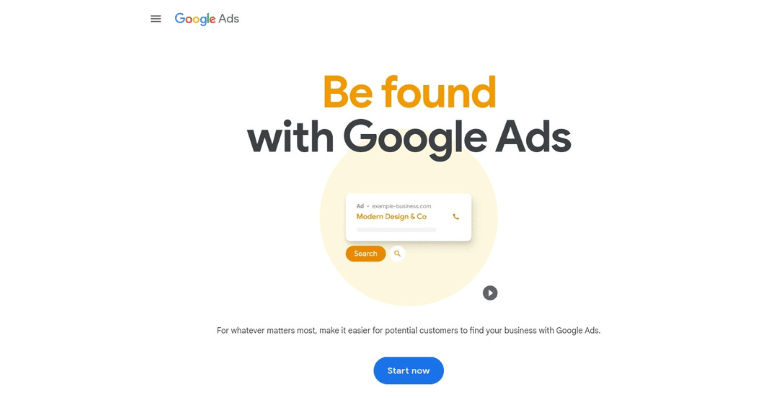SEO is crucial for driving qualified traffic to your website. And keyword research lies at the heart of an effective SEO strategy.
Google Keyword Planner is a free keyword research tool provided by Google Ads. It gives valuable insight into:
- Keyword search volume data
- Competitiveness metrics
- Related keywords
- Bid estimates
Armed with this information, you can identify the best keywords to target in your content and digital marketing campaigns.
In this actionable guide, we’ll explore step-by-step how to use Google Keyword Planner to improve your website’s SEO and content marketing.

Step 1: Sign Up for a Google Ads Account
Before you can access Google Keyword Planner, you need to create a free Google Ads account.
Here’s a quick rundown of the sign-up process:
- Go to ads.google.com and click Start Now.
- Follow the on-screen prompts to set up your account. You’ll need to agree to the services agreement and privacy policy.
- Specify your account name, time zone, and currency. Double-check all information is correct.
- Confirm your account via email. Click the verification link sent to your inbox.
- You now have access to Google Ads and its suite of free tools, including Keyword Planner!
Step 2: Access Google Keyword Planner
With your shiny new Google Ads account, you can now leverage Keyword Planner.
Here’s how:
- Visit the Google Ads homepage.
- Click the tools icon in the top right corner.
- Select Keyword Planner in the dropdown menu.
And voila! You have unlocked this powerful keyword research tool.
Step 3: Enter Seed Keywords
Seed keywords are the initial keywords you provide to Keyword Planner to generate new keyword ideas and search data.
Let’s say your website sells fitness equipment. Some potential seed keywords could be:
- Treadmills
- Exercise bikes
- Ellipticals
Here’s how to input seed keywords:
- In the keyword research tab, click Get search volume and forecasts.
- Enter your seed keywords into the input field, separated by commas.
- Check both search volume and forecast data is enabled.
- Click Get Results.
Keyword Planner will now churn away and compile data on monthly searches, competition, trends, and more for those keywords.
Step 4: Analyze Keyword Idea Results
Once Keyword Planner has processed your seed keywords, it presents the output data in the keyword ideas tab.
Let’s explore the key metrics provided:
- Average monthly searches – This shows the average searches for a keyword per month across devices. It indicates search interest and traffic potential.
- Competition – This gives a score from 0 (low) to 1 (high) on how competitive a keyword is to rank for. The higher the score, the more difficult it is to rank.
- Suggested bid – This indicates how much advertisers are bidding to show ads for a keyword. Higher bids generally mean more competition.
- Trends – This shows fluctuations in search volumes over the past year to predict seasonal interest. Look for upward momentum!
Analyze this data to find keywords aligned with your business that have good search volume, low competition, and positive trends. These present prime SEO opportunities!
Step 5: Filter Results
Manually sorting through all the keyword variations can be tedious. That’s where Keyword Planner’s filters come in handy.
Using the filters, you can cherry-pick keywords:
- In a specific search volume range
- Below a competition threshold
- With exact match status
- Containing certain words
Say you only want keywords with over 1k searches and under 0.5 competition. Simply apply those filters to narrow down the perfect SEO targets.
Step 6: Export Keyword Planner Results
Once you’ve identified your hero SEO keywords, it’s time to extract them for further analysis and integration into campaigns.
Export your filtered Keyword Planner results in one of two formats:
- .csv – For analysis in Excel, Google Sheets or other spreadsheet apps
- .gkp – For seamless transfer to tools like Google Ads that recognize this unique file type
In your Google Ads account dashboard:
- Navigate to the export tab in Keyword Planner and select your desired file format.
- In the next screen, choose whether to export impression share metrics.
- Click Export and download your ideal SEO keyword list!
Step 7: Perform Competitor Keyword Research
Want to expand your research beyond your own seed keywords? Use Keyword Planner to analyze competitors too!
Simply input a competitor’s URL into Keyword Planner’s seed tab rather than keywords. The tool generates keyword ideas based on their website content.
This reveals valuable insight into:
- Which terms are working well for rivals
- Untapped long-tail variations
- Keyword gaps you can target
Just remember to filter low volume keywords unlikely to drive significant traffic.
Step 8: Schedule Regular Checks
SEO keywords shouldn’t be a one-and-done research step. Interests and trends evolve, new terms emerge, search intent shifts.
I recommend analyzing your keyword list quarterly. Look out for:
- New keyword ideas
- Growing search volumes
- Spiking seasonal interest
- Increased competition
Rerunning top performers through Keyword Planner regularly keeps your SEO strategy aligned with what users want.
Step 9: Incorporate Keywords Into Content
Generating keyword ideas is only step one. Next, seamlessly blend researched terms into your blog posts, videos, landing pages and more.
But don’t force-fit terms—ensure content reads naturally. And focus on topics that genuinely answer audience questions.
Other integration tips:
- Include keywords in meta titles and descriptions
- Use terms appropriately in content headers
- Embed phrases within image ALT attributes
- Build silo pages around high-potential topics
This lifts both click-through rates and dwell time, driving SEO wins.
Step 10: Track Keyword Rankings
How do you know whether your keyword targeting is delivering results?
Monitor rankings in Google Search Console to benchmark improvement and spot poor performers.
Here’s a four-step process:
- Verify website ownership in Search Console.
- Submit sitemaps so all site pages are indexable.
- In the performance report, filter by keyword to isolate those you’ve optimized for.
- Track rankings over time—aiming higher for your focus keywords!
Ideally, combine this with Google Analytics to confirm increased organic traffic from prioritized terms.
Go Forth & Conquer SEO With Keyword Planner!
And there you have it—exactly how to utilize free Google Keyword Planner data to elevate your SEO game.
No more guessing at what keywords your audience actually searches for!
Now the next step is on you. Apply these tips to research and integrate high-potential keywords that align with your business niche and website content.
Monitor performance carefully in Search Console and Analytics. Double down on what drives results.
Soon you’ll reap the SEO rewards through elevated organic rankings, more qualified site visitors, and greater customer conversions!






